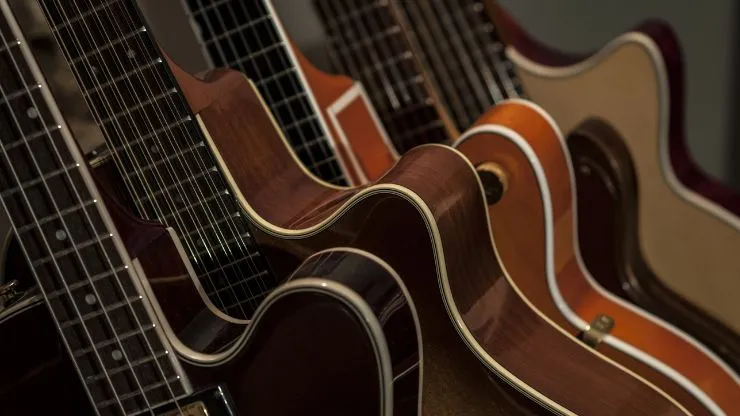As our world population grows and the effects of climate change increase, all areas of our life can be affected – and guitars are regrettably no exception. Some classic tonewoods that have defined guitars for decades are no longer sustainable. But thankfully, a new breed of tonewoods is waiting to take up the mantle. In this article, we’ll look at some of the most sustainable guitar woods around, including established favourites and future classics.
Over the years, guitarists have enjoyed some pretty special instruments crafted from the finest materials by master luthiers. But while manufacturers continue to push the envelope on guitar design, it’s undeniable that some of the most sought-after tonewoods just aren’t available in the same quantities as they have been in the past. In a perfect world, we’d be able to continue using iconic woods like rosewood and ebony, prized by guitarists for their tonal properties and appearance. But with some of the classic tonewoods now only available in seriously limited numbers, guitar makers are forced to consider alternatives.
Why Are Some of the Classic Tonewoods Unsustainable?
There are various reasons for guitar woods becoming unsustainable, with both human and natural activities to blame:
Overlogging
Particularly popular woods can have wide-ranging purposes, as is the case with rosewood, a common choice for instruments, furniture, construction, and decorative veneers. When demand for a particular wood outstretches the available tree stock, the logging activities become unsustainable.
Additionally, there are concerns about the logging practices for some theoretically sustainable woods. Sitka spruce, for instance, is available in vast numbers. However, only old-growth trees are suitable to use as tonewood. Guitar manufacturers have already utilised much of the currently suitable Sitka spruce wood. Furthermore, loggers will sometimes clear-cut large forest areas to source only a small number of suitable tree specimens.
Loss of Habitat
To keep up with a growing population, an ever-increasing amount of land is needed for agriculture and urbanisation. This can result in a significant reduction in tree stock, which is of considerable concern for both sustainability of wood and the loss of habitat for native animal species.
Climate Change
The effects of climate change on the environment are becoming more apparent, and tonewood is not immune to the issue. Changes to local weather systems, and extreme weather events, such as flooding, can and do affect previously sustainable woods. This may result in the death of tree specimens and changes to the tonal and physical characteristics of affected wood.
Pests and Diseases
Various species worldwide are affected by specific pests and diseases that deplete tree stock levels. Of particular note is the emerald ash borer, responsible for killing billions of ash trees in the U.S., resulting in supply issues with swamp ash tonewood. Ash dieback, a fungus originating in Asia, has also decimated ash trees across Europe and is forecast to kill up to 80% of ash trees in the U.K., while Phytophthora disease of alder is widespread across Europe.
What Makes a Guitar Wood Sustainable?
Despite the increasing demand and changing state of the world, plenty of trees are still viable wood sources. Fast-growing, large, and well-populated tree species are available around the globe in vast forests. At the same time, previously underutilised woods are increasingly being recognised as viable sources by manufacturers.
Furthermore, efforts are underway to protect endangered species and prevent vulnerable species from ever becoming endangered. Sustainably managed woodlands are increasing, with stewards working to ensure the preservation of forest landscapes. Additionally, organisations such as CITES and the International Union for Conservation of Nature are working hard to raise awareness of vulnerable flora and fauna and restrict the harvesting and trade of affected species.
What Are the Most Sustainable Guitar Woods?
If you’d like to be environmentally conscious with your next guitar purchase, here’s our list of ten of the most sustainable guitar woods around:
Spruce
While some individual species of spruce do have sustainability issues, in general, the tree is available in large numbers, with spruce forests found across the northern temperate region. As a tonewood, spruce is the most popular choice for acoustic guitar soundboards and offers excellent projection, clarity, and warmth. Tonally, it also has a tremendous dynamic range, with tight lows, solid mids, and bell-like treble.
Western Red Cedar
With a sound reminiscent of mahogany, finger pickers love western red cedar for its warmth and tendency to pair nicely with gentler play styles. One of the most widespread trees in North America’s Pacific Northwest, it’s native to some of the world’s most sustainably managed forests and has been introduced into other temperate zones.
Basswood
Abundant in Europe and North America, where it grows at twice its harvesting rate, basswood is incredibly sustainable. While some people consider it an inferior tonewood, good quality basswood has a warm and even tone with an excellent, mix-friendly mid-range boost. Perfect for riff clarity in rock and metal.
Maple
One of the classic tonewoods, guitar makers use various species of maple, none of which appear in the CITES Appendices or on the IUCN Red List. A popular choice for electric and acoustic bodies, necks, and even fretboards, maple offers great projection, good note separation, and a well-balanced, tight tone.
Ash
Except for swamp ash, which is no longer sustainable due to extensive flooding in harvesting locations and the impact of the emerald ash borer, ash is a widely available and popular tonewood choice. It offers a well-balanced tone with tight lows and bright highs, along with excellent sustain and resonance. Ash is most famous for its use in Fender’s iconic Stratocaster and Telecaster models, the weapons of choice for some of rock’s most accomplished guitarists.
Redwood
Redwood is a classic acoustic guitar tonewood with a similar sound profile to cedar. It offers excellent note separation and a dynamic tonal range, with a solid performance in the upper mids. Preservation efforts, including selective harvesting of fast-growing redwood trees grown in young forests, have helped sustain the species.
Limba
Also known as korina, limba might not sound familiar, but it’s appeared in some iconic guitars. Notable models include the original Explorer and Flying V guitars from Gibson. Sonically, it has a lot in common with mahogany; excellent mids, defined lows, and outstanding resonance. Interestingly, limba was subject to an unsustainable harvest rate in the early 20th century. However, extensive preservation efforts and a massive replanting program have successfully safeguarded the species.
Koa
Koa only grows in Hawaii, meaning it has a limited distribution. But despite this, extensive preservation efforts, including requiring permits to harvest koa timber, mean that state agencies have safeguarded the sustainability of the species. Sonically speaking, koa blends the mid-range performance of mahogany with maple’s highs, often becoming warmer and less bright after extensive playing.
Laurel
Laurel is an increasingly common alternative to rosewood. It offers similar tonal characteristics, albeit with a little more brightness and a more scooped mid-range. One of the sustainable alternative tonewoods that are becoming more commonplace in the modern guitar market, laurel is abundant across India and South Asia.
Ovangkol
A relative of rosewood, ovangkol is another substitute for the legendary OG tonewood. It’s appearing more frequently in models from brands such as Taylor, Martin, and Fender. Unsurprisingly, it has similar tonal properties as rosewood but with a little brighter highs and a more robust mid-range response. Ovangkol also offers excellent resonance and sustain.
Find Your Sustainable Guitar
If you want to get your hands on a sustainable guitar, then try out our fantastic Finder tool! Pick your axe requirements, including wood, budget, and body type, and start the hunt for your ideal sustainable guitar.

